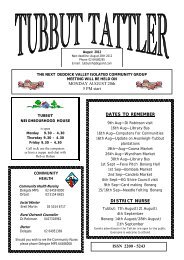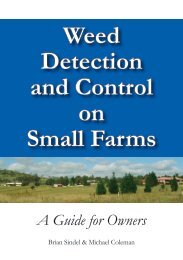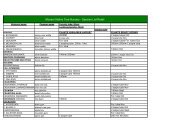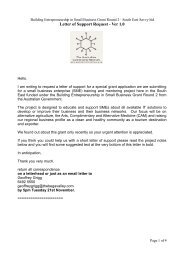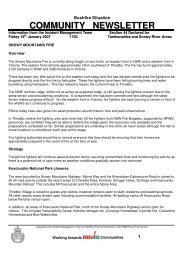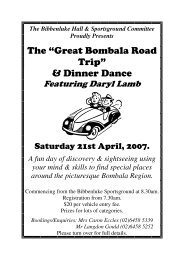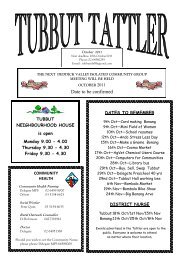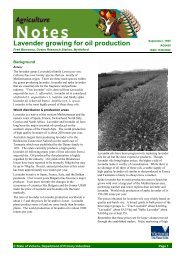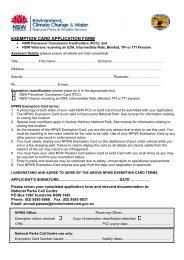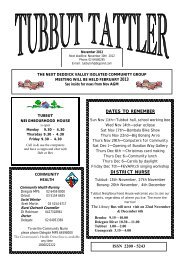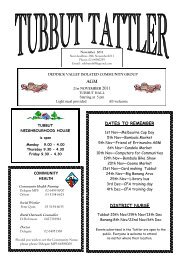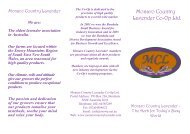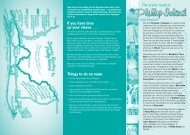September 2011 Tattler.pdf - Platypus Country
September 2011 Tattler.pdf - Platypus Country
September 2011 Tattler.pdf - Platypus Country
You also want an ePaper? Increase the reach of your titles
YUMPU automatically turns print PDFs into web optimized ePapers that Google loves.
News from the Departments<br />
Parasites<br />
Sheep can recycle their own parasites but they can also<br />
pick them up from wild animals. Hares and rabbits may be<br />
a vector for transmission of worms and other parasites,<br />
according to research being conducted by a Brazilian<br />
student as part of her post-graduate Veterinary Science<br />
degree.<br />
Late crop sowing warning<br />
Wet paddocks have virtually drowned any hope of<br />
traditional winter sowing in some high rainfall districts this<br />
year and in some instances spring sowing is emerging as<br />
a real possibility.<br />
Before sowing, croppers need to carefully consider a<br />
number of factors and risks according to an article in ‗The<br />
Break‘ newsletter by Ash Wallace from the Department of<br />
Primary Industries (DPI).<br />
Mr Wallace said one common question related to the<br />
expected yield loss from sowing in spring.<br />
―While actual cases of spring sowing in Victoria have been<br />
limited in recent dry years, scientists at DPI Hamilton have<br />
used the APSIM crop model to predict potential yields for<br />
a wide range of sowing times across a number of sites in<br />
the South West based on 120 years of climate data,‖ he<br />
said.<br />
―The APSIM model is driven by interactions between<br />
climate, physical soil characteristics, soil moisture, soil<br />
nitrogen, crop type and variety. It doesn't account for<br />
other nutritional<br />
disorders, pests, diseases or stress from temperature<br />
extremes.<br />
Mr Wallace said one of the key risks for such late sowing<br />
was heat stress around flowering and the APSIM outputs<br />
help to illustrate this point by predicting time of flowering<br />
for different sowing dates and varieties which can then be<br />
related to the risk of heat stress at a given time.<br />
―The results suggested that in high rainfall areas yield<br />
potential for spring sown crops would be considered quite<br />
respectable for conventionally sown crops in lower rainfall<br />
areas.<br />
―However the risk of heat stress at flowering is quite high<br />
and may affect both yield and quality. This can be<br />
reduced by sowing early and choosing early maturing<br />
varieties.<br />
―While current soil moisture levels are good, there is still<br />
the risk of a dry spring and early summer, and this<br />
increases as you move closer to medium rainfall areas.<br />
―This could be managed by grazing the crop or cutting<br />
them for hay if sufficient bulk is produced from current<br />
moisture levels.<br />
―There are also logistical, nutritional, pest, disease and<br />
marketing considerations in the spring sowing decisionmaking<br />
process.<br />
―While the wet winter has been frustrating and limiting for<br />
some high rainfall croppers, spring sowing presents as an<br />
opportunity for some.<br />
―Before you sow it is vital to seek further information and<br />
conduct a rigorous assessment of the risks involved.‖<br />
Further information on spring sowing and managing<br />
climate risk is available in ‗The Break‘ electronic<br />
newsletter which is distributed free of charge by DPI. To<br />
subscribe, email your details to:<br />
the.break@dpi.vic.gov.au<br />
Funding available to voluntary environmental<br />
groups<br />
Landcare Australia and Be Natural are pleased to<br />
launch a $125,000 grants program that will provide<br />
funding to voluntary environmental community groups<br />
across Australia. The grants program will enable<br />
groups to continue work in tackling local environmental<br />
issues by providing funding to help with the<br />
continuation of on-going projects.<br />
The Be Natural Landcare grants program provides<br />
grants of up to $5000 to 25 local groups to help with<br />
projects which have not received funding in the last 12<br />
months. The program also encourages groups to find<br />
innovative ways of attracting more volunteers.<br />
http://www.landcareonline.com.au/news/archive/benatural-landcare-grants-now-open/<br />
Tractor safety needs more focus<br />
WorkSafe Victoria is warning farmers to take more<br />
care around tractors after a vegetable farmer on a<br />
farm at Pearcedale escaped with his life after the<br />
second serious incident involving a tractor in Victoria<br />
in a matter of days. The tractor was moving slowly<br />
when the 49-year-old stepped off to check seed<br />
dispensers, but it appears he slipped on the step and<br />
was run over by the tractor which weighed nearly three<br />
tonnes.<br />
Rural communities to benefit from Carbon<br />
Farming Initiative<br />
Farmers will be able to access international and<br />
domestic carbon markets under legislation passed by<br />
Parliament to establish a regulated carbon offsets<br />
market in Australia.<br />
Increasing carbon in soils or vegetation, or lowering<br />
emissions from livestock or fertiliser use creates the<br />
potential to generate carbon credits for landholders<br />
that can be sold to companies who wish to offset their<br />
carbon pollution.<br />
More carbon farming possibilities are being<br />
investigated including manure management, fertiliser<br />
management, savanna burning and managing<br />
methane from livestock.<br />
Later this year the Administrator for the Carbon<br />
Farming Initiative will begin operating and eligible<br />
projects can backdate credits to July 1, 2010.<br />
www.daff.gov.au/climatechange/cfi




